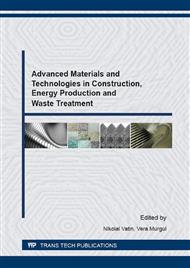[1]
Yu.B. Potapov, Yu.M. Borisov, S.A. Pinaev. High-performance sandwich composite elements and structures, Voronezh, (2002).
Google Scholar
[2]
Yu.B. Potapov Yu.M. Borisov, S.A. Pinaev, E. N Savchenko. RubCons - the new class of corrosion-resistant building materials, Construction materials of the 21st century. - 2000. - No. 9. - pp.9-10.
Google Scholar
[3]
S.A. Pinaev. Effect of Polymer-Cement Protection on Crack Resistance of Reinforced Concrete Bending Elements. Journal Scientific Israel-Technological Advantages", "Scientific Herald, of Voronezh State University of Architecture and Civil Engineering, Vol. 15, № 4, 2013. pp.93-96.
Google Scholar
[4]
S.A. Pinaev, Francisco Saviti Matias Da Fanseca. The influence of polymer-cement protection on cracks with regard to reinforced concrete bending elements. Scientific Bulletin of Voronezh State University of Architecture and Civil Engineering, Series: High technology. Ecology. 2011. Vol. 1. pp.85-88.
Google Scholar
[5]
S. A. Pinaev, Short the compressed elements of building designs from an effective composite on the basis of polybutadiene oligomers: abstract of Ph. D. thesis. Voronezh, (2001).
Google Scholar
[6]
Yu.B. Potapov, Yu.M. Borisov, D.V. Panfilov, V.A. Chmihov, A. Polikutin, O.E. Perekalski, V.A. Govorov, A.V. Voronov. Patent RUS 2261232 . Polymer-concrete composite. 09. 02. (2004).
Google Scholar
[7]
M.A. Visotskaya, S. Yu. Rusina, D.A. Kuznetsov, D.E. Barabash Road-building materials based on modified organic cementic agents. The World of Roads, 2014. No. 78, p.53.
Google Scholar
[8]
M.A. Visotskaya, D.A. Kuznetsov, S. Yu. Rusina, Radchenko I.S., D.E. Barabash Polymer-modified materials for road-building industry. Collected articles: Innovation materials, technologies and equipment for construction of advanced transport structures. Belgorod State Technological University named after V.G. Schukhov. Belgorod, 2013. pp.91-95.
DOI: 10.33979/2073-7416-2020-90-4-104-111
Google Scholar
[9]
M.A. Visotskaya, D.A. Kuznetsov, D. E. Barabash. Nanostructured road-building materials based on organic binders. Construction and Building Materials. 2013. № 4. pp.20-24.
Google Scholar
[10]
Yu.B. Potapov, A. Polikutin, M.M. Okunev, A.V. Levchenko, A.V. Kovalenko, A.G. Kruttskih. To study of strength and fracture toughness of normal sections, Caetano-concrete bending elements of the profile. Scientific Bulletin of Voronezh State University of Architecture and Civil Engineering, Series: Advanced technology. Ecology. 2015. № 1. pp.64-70.
Google Scholar
[11]
Yu.M. Borisov, A. Polikutin. Research of reinforced two-layer beams made from conventional and rubber concretes Nguyen Phan Duy. Scientific Israel - Technological Advantages. 2012. Т. 14. № 2. pp.11-15.
Google Scholar
[12]
Yu.M. Borisov, A. Polikutin, Phan Duy Nguyen. Stress-strain state of normal cross-sections of two-layer caoutchouc concrete-concrete bending elements of building structures. Scientific Herald of the Voronezh State University of Architecture and Civil Engineering. Construction and Architecture. 2011. № 2. pp.6-13.
DOI: 10.22227/1997-0935.2016.3.26-36
Google Scholar
[13]
SNiP 2. 03. 01-84*. Concrete and reinforced concrete structures. / Gosstroy of Russia - M., GUP TsPP, (2000).
Google Scholar


